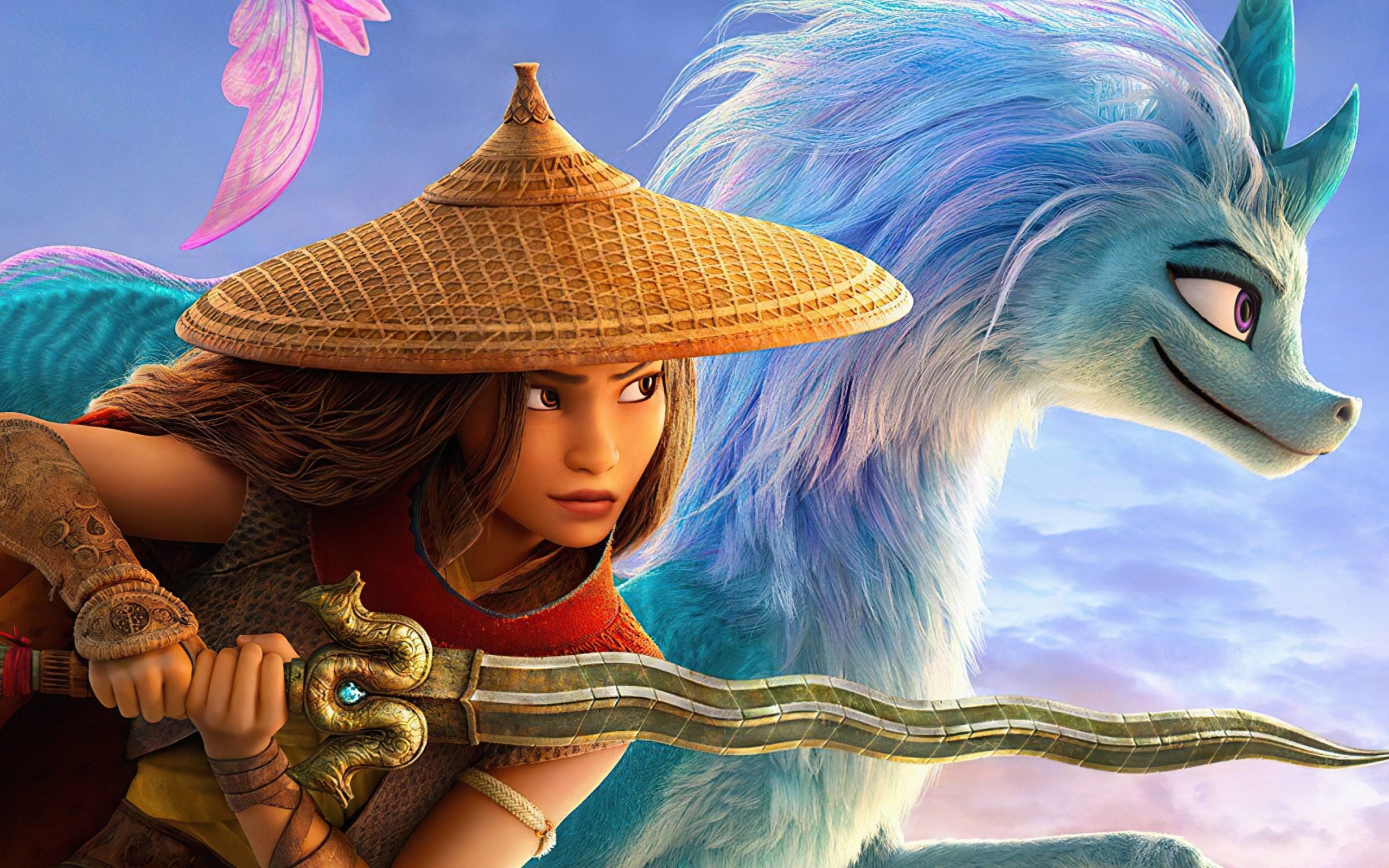NOTE: “Raya and the Last Dragon” is available to watch in theatres here in North America, and many other parts of the world, wherever theatres are permitted to be open. It is also available to watch at home on Disney+, via a one-time, “Premier Access” fee for the next several months, before becoming free to view at home for all Disney+ subscribers later this year. When possible, we recommend watching movies at home for the duration of the ongoing COVID-19 pandemic, for the safety of yourself and others. In the event that you do attend a movie theatre over the course of the ongoing pandemic however, please consult and follow public health guidelines in your region, and do not attend movie theatres if you feel unwell, or have been potentially exposed to COVID-19 through a known positive case.
FOR REFERENCE: This review of, “Raya and the Last Dragon” is based on an at-home viewing via Disney+ Premier Access.
Without trust, we have nothing as a species. This principle runs at the core of Disney’s latest in-house animation project, Raya and the Last Dragon, one of numerous newly-released movies that was originally supposed to premiere in theatres last year, only to be bumped into 2021 due to complications caused by the ongoing COVID-19 pandemic, and its persistent shuttering of movie theatres across the world. Following last year’s live-action Mulan remake making lemonade and experimenting with the format last September as well, Raya and the Last Dragon marks the second movie that Disney is immediately debuting on Disney+ via a one-time additional fee (albeit this time with a simultaneous option to watch it in theatres globally), as a means of accommodating moviegoers that can’t or won’t currently attend a movie theatre in their region.
The first time Disney attempted this Disney+ Premier Access idea with 2020’s Mulan remake, it didn’t go over too well with audiences. Mulan was nonetheless commercially successful, when you factor in that it didn’t even offer a theatrical option in most parts of the world in the end, but paying an additional Premier Access fee for a movie that many early viewers were rather lukewarm on in the end stung quite a bit for those on a monthly Disney+ payment plan especially. The currently necessary evil of Disney+ Premier Access goes down a little easier with Raya and the Last Dragon though, both because this movie actually can be seen in theatres if you’re lucky enough to live in a region where they’re still open at the time of writing, and also because of the plain and simple fact that Raya and the Last Dragon is many times better than the Mulan remake. In fact, it’s 2021’s first legitimately superb, must-see cinematic blockbuster!
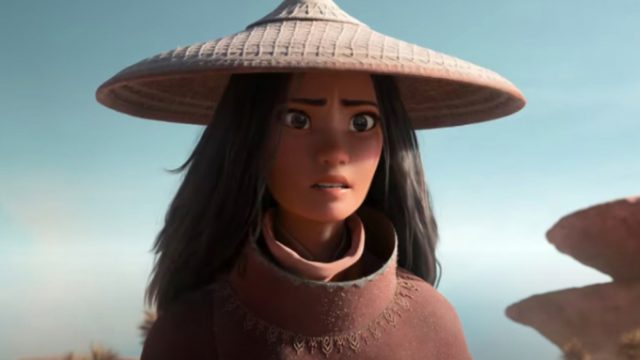
Granted, Raya and the Last Dragon is another Disney movie that, like the live-action Mulan remake before it, blatantly feels like it was primarily designed to appeal to Asian markets most of all, and one that particularly craves the red-hot box office dollars of China. Despite its clear commercial designs however, Raya and the Last Dragon feels smarter and more universally appealing than the stylish, but more selectively appealing Mulan remake. Its tale of human unity in the face of overwhelming odds feels incredibly timely, what with the COVID-19 pandemic still having yet to be truly quelled in many regions of the world at this point, plus its well-performed characters and rich world lore feel impressive by the standards of any region, not just the Southeastern Asian heritage that Raya and the Last Dragon is most heavily taking inspiration from.
Yes, the Premier Access fee nonetheless stings for those of us still opting or being forced to watch new movie releases at home for now, and you could still be forgiven for opting out of that system and just waiting for Raya and the Last Dragon to drop on Disney+ at no extra cost for subscribers later in 2021. Regardless of whether you see the movie in theatres, via Disney+ Premier Access, or later when it becomes free to every Disney+ subscriber though, Raya and the Last Dragon is a wholesome, accessible adventure for kids, and a thematically rich, visually stunning odyssey for adults. It’s yet another home run for Walt Disney Animation Studios, especially when its over-arching message of harmony feels more necessary than ever during these challenging times.
Raya and the Last Dragon stars eponymous heroine, Raya, voiced by Kelly Marie Tran, who ultimately took over the role from original lead actress, Cassie Steele during production. Raya is a princess of the Kumandran tribe, Heart, one of five tribes that splintered from a formerly united land, after they went to war over the last remnants of a dragon’s power. Nonetheless, Raya’s father, Benja, voiced by Daniel Dae Kim, aspires to unite the separated tribes that once formed Kumandra, which ultimately ends in disaster, and unleashes an ancient enemy force, the Druun on the world again. Six years after this, everything has practically been turned to stone by the Druun, leaving a mostly failing world that a now-adult Raya must travel through, in one last desperate effort to summon the world’s last remaining dragon, Sisudatu, or just, “Sisu” for short, voiced by Awkwafina, who possesses the necessary magic to expel the Druun and reverse everyone’s petrification.
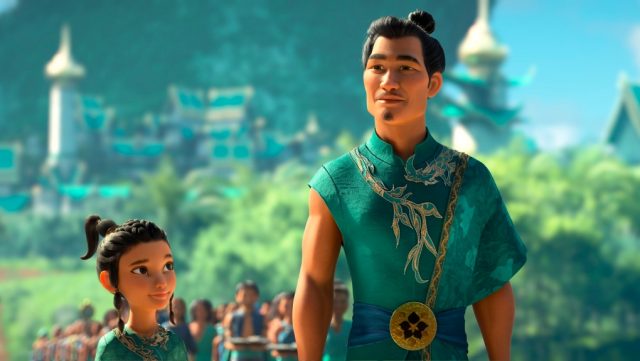
Without spoilers, the marketing has already made it very evident that Raya successfully meets Sisu early on, especially considering the high billing of Awkwafina in the cast. The rest of the story and its subsequent personalities are best enjoyed knowing as little as possible about the cast though, as Raya’s journey pits her against personalities from competing tribes, Spine, Tail, Talon and Fang. These personalities share their own esteemed voice cast, with Gemma Chan portraying key Fang personality, Namaari, Benedict Wong portraying central Spine personality, Tong, and, outside of the tribe system, Alan Tudyk also returns for his latest offering of humourous Disney animal voiceover as Raya’s faithful… Furry armadillo (?) sidekick, Tuk Tuk. Nonetheless, every character is voiced impeccably, and the many exotic personalities that Raya encounters over the course of her quest all contribute something special to a mission that effectively builds in scale from a fruitless solo effort to an almost adorable buddy adventure.
Disney’s modern commitment to representation also shines throughout Raya and the Last Dragon, which may not manage a perfect cast of Southeast Asian representation specifically, but nonetheless presents a standout commitment to overall Asian representation, leaving only Tudyk as a high-profile exception. Raya herself is also another fantastic step in the evolution of Disney Princesses, being a remarkably skilled, resourceful and intelligent adventurer that nonetheless feels like a likable, grounded human being with relatable concerns and goals. Better still, Raya’s empowerment and convictions feel more believable and universally recognizable than those of the live-action Mulan before her, who was a more boilerplate, “Chosen one” protagonist that seemed almost exclusively rooted in Eastern narrative convention.
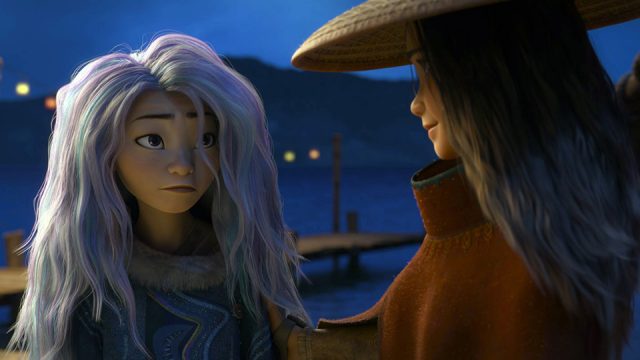
Raya, on the flip side, represents a better character design overall (and I say that as someone that kind of liked last year’s Mulan remake!), one that’s proudly rooted in her Southeast Asian inspiration, but one that also isn’t bound by that in terms of her character development. She earns her skills, and faces her obstacles with earnest cunning and strength, never truly having any of her lessons, experiences or accomplishments merely handed to her, something that’s quite an achievement in a story about surrendering control and trusting others! Raya and the Last Dragon may have been blatantly inspired by real-world Asian mythology and history from regions like Vietnam, Malaysia, Singapore and Laos (with some Chinese mythology elements thrown in, naturally), but its themes and character designs feel universal because their development is relatable and earned, transcending the characters’ backgrounds to build a story that anyone of any age or any ethnicity can easily relate to. Not only that, but Raya and the Last Dragon’s strong sense of humour and similarly strong sense of adventure help to keep viewers easily engaged throughout, further complementing a set of personalities that are just as fun as they are inspiring!
Raya and the Last Dragon’s fulfilling and emotionally evocative story doesn’t always play to expectations, and that will immediately make it intriguing and easy to invest in for both children and adults. Just the fact that the core of the movie’s plot is a virtual post-apocalyptic narrative feels pretty bold for an in-house Disney production (even if Pixar’s WALL-E presented its own post-apocalyptic plot for the House of Mouse over a decade ago), initially dropping an adult Raya into a world that feels legitimately treacherous, and full of hazards around every corner. This world does get friendlier and more hopeful as the runtime goes on, but its initial presentation of a dying world overrun by the Druun is surprisingly jarring, seemingly promising a darker, more challenging take on a familiar Disney animation formula.
In the end though, if there is one slight issue that tends to stick out about Raya and the Last Dragon, it’s the fact that it doesn’t ultimately challenge Disney’s in-house animation formula to any meaningful degree. The buildup, climax and ultimate resolution fit completely with the same formula behind the past few Walt Disney Animation Studios projects, and this movie’s otherwise harsh landscape ultimately fails to commit to a potentially darker, more emotionally subversive story, which Raya and the Last Dragon feels primed to present in concept. At worst, this feels like lost potential, with Disney once again going right up to the line of comfort with Raya and the Last Dragon’s darker moments, but still never truly crossing it in the end.
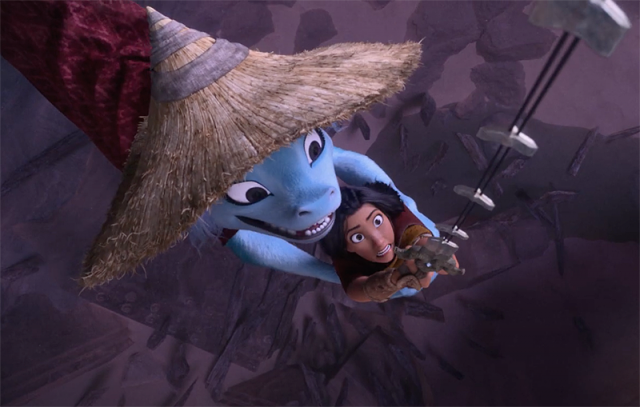
Even if it sometimes stumbles over its own necessary adherence to the well-established Disney animation formula however, Raya and the Last Dragon’s plotline nonetheless remains tight and wonderfully presented. The evolution of Raya’s journey, while it stays very firmly in the realm of child-friendly territory, takes her to a smorgasbord of alternate cultures and unexpected challenges, though it also places her on the path to friendship and greater character fulfilment, especially with the hyper-optimistic, affectionately naive Sisu at her side. The movie’s eventual conclusion also perfectly encapsulates the core themes of trust and unity, which, like I said, feel more timely than ever in 2021, while the world continues to be divided by the ongoing scourge of the COVID-19 pandemic.
Much like its surprisingly crowded, but largely superb script credits, Raya and the Last Dragon is the product of a few directors at once, most of whom are veterans of 2014’s Marvel Comics-inspired Walt Disney Animation Studios movie, Big Hero 6. The exception is Carlos Lopez Estrada, who only recently joined Disney’s ranks in 2019, and is best known for directing shorts at this point, as well as, strangely enough, 2018’s indie dramedy, Blindspotting. The other two men behind Raya and the Last Dragon’s direction are Don Hall and Paul Briggs, respectively the director and head of story for Big Hero 6.
Hall and Briggs previously helped put together a visually impressive, if slightly simplistic product in Big Hero 6, and it seems that both of them are pushing their directing ambitions further this time. Perhaps Estrada is part of this recipe, but either way, Raya and the Last Dragon carries a lot more thematic impact and ambition than the Saturday morning cartoon stylings of Big Hero 6. Briggs is technically in a co-direction role, while Hall and Estrada are the primarily credited directors on Raya and the Last Dragon, but it nonetheless feels apparent that Briggs’ knack for exciting, action-packed animation is back and better than ever here. Even if it is an animated movie, Raya and the Last Dragon is so exciting and well-polished that it feels like it can easily compete with many of Disney’s live-action blockbusters on this note, at least those outside of the sky-high standards for the Marvel Cinematic Universe or Star Wars universe anyway.
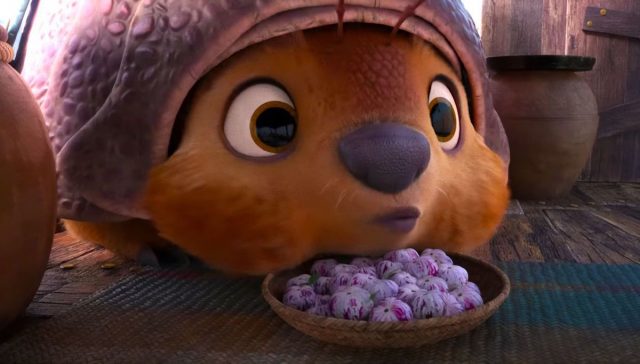
The rest of the direction is careful not to let the style override the substance though. As much as it’s a fast-paced, riveting adventure, Raya and the Last Dragon also excels during its quieter, more introspective character moments. There’s just enough passing moments of self-examination and cheeky humour to avoid over-complicating the story for young children, but you still get an adventure in Raya and the Last Dragon that feels like it has pressing stakes. The world itself is at stake in Raya and the Last Dragon in a way that most mainline Disney productions don’t quite capture, and while it avoids fully committing to a lot of its gloomy outlook on the state of its world (this is still an animated Disney movie, after all), there’s a staggering sense of scope throughout this movie. The weight of failure isn’t hurt feelings or the loss of a kingdom. It’s legitimate oblivion, and yet, this movie’s quest is still light and inviting enough to please children. This is a very tough line to walk, but Raya and the Last Dragon makes it look easy, flawlessly bringing together its trio of directors’ visions into an animated opus that carries a big heart to keep pace with its fleet feet.
James Newton Howard puts together a wonderful score for Raya and the Last Dragon, one that hits every emotional and action-packed note perfectly! The movie’s music suite is full of authentic Asian instrumentation, combined with a modern Hollywood flavour that creates the feeling of an adventure both exotic and reliably cool. The quieter moments are also similarly effective, moving into charming, almost cartoon-ish compositions during the lighter scenes, without missing a beat. Finally, all of this is complemented by a tie-in single, “Lead the Way” by Jhene Aiko, a charming earworm that may feel a lot softer and less bombastic than the Mulan remake’s big single, “Reflection”, but it still finds itself effortlessly catchy and true to the spirit of the movie. It’s a little surprising that this single plays so softly in fact, considering that some of the instrumentation in Raya and the Last Dragon’s main score feels so punchy and gripping, but it’s nonetheless a fun, inoffensive tune that’s well-suited to an animated Disney blockbuster.
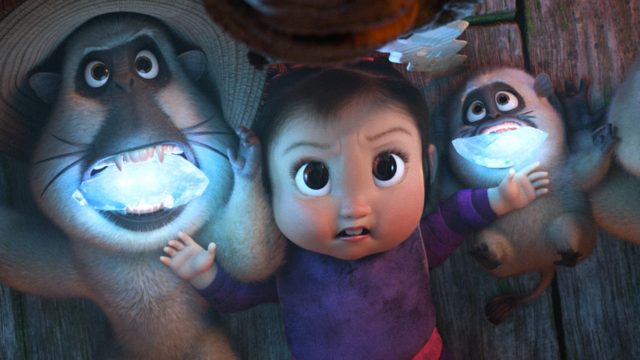
The rest of this movie’s audio is similarly polished and well-presented, though in true Disney fashion, the action scenes are pretty careful not to sound too powerful or frightening, while still conveying the desired degree of danger. Several of the best audio flourishes in Raya and the Last Dragon are actually reserved for the quieter scenes too, particularly those involving water, a central element and bit of symbolism throughout Raya and the Last Dragon’s story. The excitement can be very palpable, but there’s also something strangely soothing about the sound design throughout Raya and the Last Dragon, a production that somehow manages to perfectly balance real stakes with cartoon whimsy.
Walt Disney Animation Studios continues to set the bar for cutting-edge CG filmmaking, and that bar is raised again with Raya and the Last Dragon. The studio’s latest CG-animated production realizes one of its biggest, most impressive worlds yet, in fact! The range of lighting, colour and environmental designs are absolutely breathtaking here, with the broken, scattered sub-regions that once formed the land of Kumandra all having a distinct, memorable identity, one with their entire histories and cultures seemingly written on the very landscapes around them. Likewise, the richly-detailed characters not only look equally distinct and impressive, but they also move and react with their own unique styles, further representing the various tribes’ singular fighting backgrounds. This includes Raya’s resourceful, martial arts-heavy style of the Heart tribe, emphasizing range and flow (which is appropriate for a solo heroine!), while the assassin-themed characters of Fang move more creepily and unpredictably, among other examples.
Where the outstanding animation best flexes its visuals however is throughout the imaginative features that are uniquely designed for Raya and the Last Dragon’s world. Whether it’s the furry hide and ethereal glow of Sisu’s dragon form, or the overall excellent water rendering that lends itself to all manner of key scenes, Raya and the Last Dragon deftly sets itself apart from similar fantasy-themed media, thanks largely to how much charming creative inspiration is packed throughout its setting. Kids especially will easily be taken in by the diverse and vibrant visual palette throughout the animation, even while some of the finer themes of the story do better at provoking the acumen of adults.
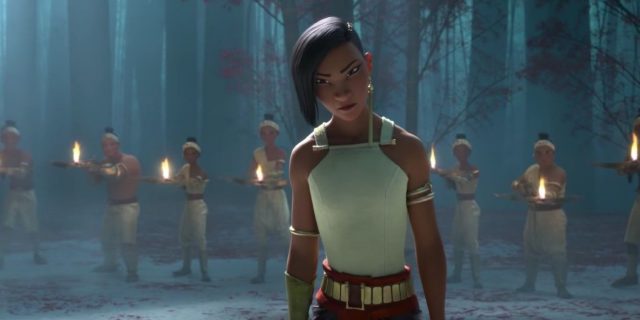
Despite how bright and cheerful the otherwise semi-post-apocalyptic world of Raya and the Last Dragon is though, its animation similarly shines during moments of darkness and tragedy. The reverent-looking stone forms of anyone touched by the Druun look nicely haunting without being scary, most notably, conveying the stakes of the story effectively, even to young children. Likewise, the Druun themselves represent some of the strongest, most creatively impeccable animation on offer in Raya and the Last Dragon to boot, functioning as an eldritch mix of swirling, mesh-like shadow around a chilling, otherwordly purple light. They’re beautifully presented as unnatural, memorable foes, existing as a force of nature that can’t be directly destroyed, which only makes them more impactful as a threat.
I can’t stress enough how beautifully produced and animated Raya and the Last Dragon is overall. The only disappointing element of its animation was the fact that I wasn’t able to experience this movie’s beautiful visual suite on the big screen, and preferably in 3D, which is clearly where this production is best meant to thrive. Still, even if you’re watching it at home on Disney+, or some other preferred VOD platform, Raya and the Last Dragon remains another outstanding visual showcase for Walt Disney Animation Studios, who remain the cream of the crop in the medium of CG filmmaking.
Raya and the Last Dragon is another standout offering from Walt Disney Animation Studios, and one that actually justifies its Premier Access pricing with a family home viewing, if you’re a Disney+ subscriber that doesn’t want to wait another several months to stream the movie at no extra cost. It’s still an animated Disney movie, and that naturally means that it still follows an established feel-good formula for the most part, but the outstanding creativity, production values and commitment to cultural representation behind Raya and the Last Dragon all come together to make one of Disney’s most ambitious animated movies to date, and one that achieves the bulk of its ambitions with aplomb!
Raya herself is an inspiring, empowered heroine that continues to represent a fantastic evolution for Disney Princesses, and the world she lives in is just as effortlessly appealing, consistently leaping to life with light, colour and energy. Likewise, the humour and excitement are both top-notch for kids and adults alike, even if a few child-pandering fart jokes and mugging moments are still snuck in here and there, albeit fortunately very rarely. Best of all though, Raya and the Last Dragon employs a simple, accessible idea, and wonderfully utilizes it to sustain a world and a quest that’s rich with character, imagination and heart. Even as it primarily adapts a specific blend of Southeast Asian culture and history, Raya and the Last Dragon’s appeal is universal, and its final product is both heartfelt and entertaining, while also soaring as another technical masterwork for Disney’s in-house animation studio.
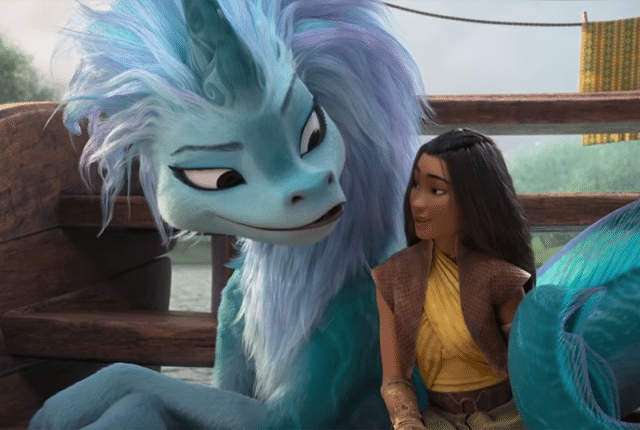
This movie is best enjoyed in a theatre for sure, should they be open in your area (and assuming it’s safe for you to attend one!), but even when watched at home, Raya and the Last Dragon stands as 2021’s first truly exceptional blockbuster. We may not be out of the COVID-19 pandemic yet, but this is exactly the kind of cinematic experience that we need to be inspired about seeing the rest of it through, reminding us that when it comes to enduring a crisis and looking out for one another to the best of our ability, even without a tangible quid pro quo, we are, and always have been, all in this together.

